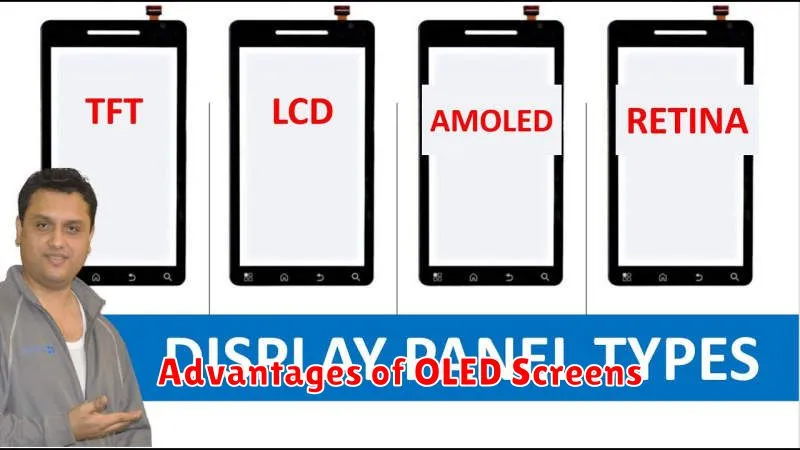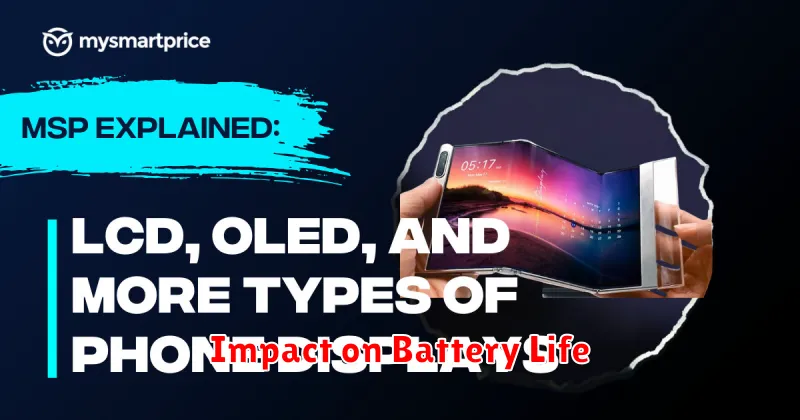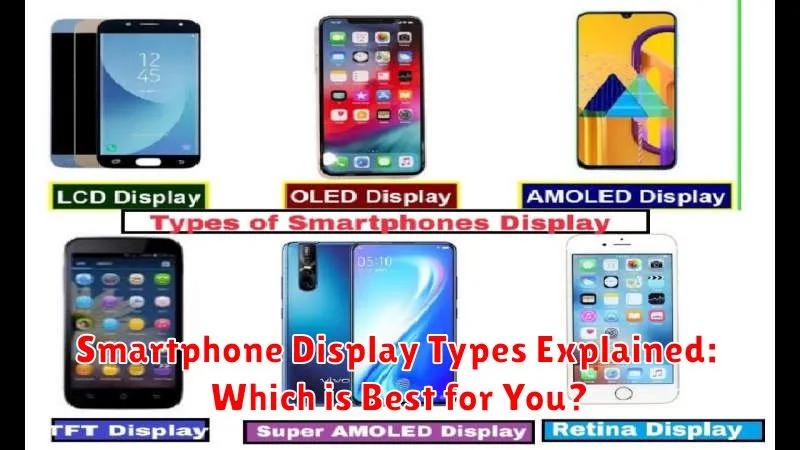Choosing the right smartphone can be overwhelming, and the display is a critical factor in your decision. Understanding the different smartphone display types is essential for making an informed purchase. This article will explore the various display technologies available, including OLED, AMOLED, LCD, and more, outlining the advantages and disadvantages of each. We will delve into key specifications such as resolution, refresh rate, brightness, and color accuracy to help you determine which smartphone display type best suits your needs and preferences. Whether you prioritize vibrant colors, battery life, or affordability, this guide will equip you with the knowledge to make a confident choice.
From the vivid hues of AMOLED to the power efficiency of LCD, each smartphone display technology offers a unique set of characteristics. We’ll break down the complexities of pixel density, contrast ratios, and other important display specifications. By the end of this article, you will have a comprehensive understanding of how these factors influence your viewing experience and be able to choose the best smartphone display for your individual requirements. Are you looking for a smartphone display that excels in bright sunlight or one that delivers deep blacks and incredible detail? This article will provide the answers you need.
Understanding LCD Displays
Liquid Crystal Displays (LCDs) are a common display technology used in many electronic devices, including smartphones. They work by using liquid crystals to control the passage of light. These crystals don’t produce light themselves, hence the need for a backlight.
There are different types of LCDs, including Twisted Nematic (TN), In-Plane Switching (IPS), and Vertical Alignment (VA). Each type has its own strengths and weaknesses regarding color reproduction, viewing angles, and response times.
Key factors influencing LCD quality include the backlight type (LED, CCFL) and the resolution (number of pixels). These factors directly impact the clarity, brightness, and overall viewing experience.
Advantages of OLED Screens

OLED (Organic Light Emitting Diode) screens offer several key advantages over other display technologies. Individual pixels emit their own light, eliminating the need for a backlight. This results in true blacks and an infinite contrast ratio, as unlit pixels are completely off.
This characteristic also contributes to significantly lower power consumption, particularly when displaying darker content. Furthermore, OLEDs boast wider viewing angles than traditional LCDs and offer faster response times, leading to smoother motion in videos and games.
OLEDs are also known for their vibrant colors and high brightness levels. Their flexible nature allows manufacturers to create curved and foldable displays, opening up new possibilities for smartphone design.
AMOLED vs. Super AMOLED
Both AMOLED (Active-Matrix Organic Light-Emitting Diode) and Super AMOLED are variations of OLED technology, known for vibrant colors and deep blacks. The key difference lies in the integration of the touch layer.
In AMOLED displays, the touch layer is separate from the display panel. Super AMOLED integrates the touch sensor directly into the display, resulting in a thinner overall display and potentially better touch sensitivity.
This integration also allows for a brighter display and reduced glare in sunlight, often making Super AMOLED a preferred choice for mobile devices.
Pros and Cons of Retina Displays
Retina displays, popularized by Apple, are characterized by their high pixel density. This means more pixels are packed into the same area, leading to sharper images and text. The term “Retina” itself isn’t a technical specification, but rather a marketing term signifying that individual pixels are indistinguishable to the naked eye at a typical viewing distance.
Pros
- Sharper Images: Increased pixel density results in crisper images with smoother lines and curves.
- Improved Text Clarity: Text appears significantly sharper and easier to read, particularly beneficial for smaller font sizes.
- Enhanced Visual Experience: Overall, Retina displays provide a more visually appealing and immersive experience.
Cons
- Higher Cost: Manufacturing displays with higher pixel densities typically increases the cost of the device.
- Increased Power Consumption: More pixels require more power to illuminate, potentially impacting battery life.
Refresh Rates and Why They Matter
A display’s refresh rate measures how many times per second the image on the screen refreshes. It’s measured in Hertz (Hz). A higher refresh rate results in a smoother, more fluid visual experience, particularly noticeable when scrolling through content or playing games.
A standard refresh rate is 60Hz, meaning the image refreshes 60 times per second. However, many modern smartphones now offer higher refresh rates like 90Hz, 120Hz, or even 144Hz. These higher refresh rates make animations appear less blurry and more responsive, reducing motion blur and improving overall visual clarity.
Brightness and Outdoor Visibility
Brightness plays a crucial role in outdoor visibility. A brighter display makes it easier to see content under direct sunlight. Measured in nits, a higher nit value generally indicates better visibility outdoors.
Different display technologies have varying brightness capabilities. Look for displays with high peak brightness levels, typically above 500 nits, for comfortable viewing in bright conditions.
Besides brightness, other factors like screen reflectivity and contrast ratio also influence outdoor visibility. Anti-reflective coatings can significantly improve readability by minimizing glare.
Screen Resolutions and Clarity
Screen resolution plays a vital role in the clarity and sharpness of a display. It refers to the number of pixels that make up the screen, expressed as a width x height value (e.g., 1920 x 1080 or 2560 x 1440). Higher resolutions mean more pixels packed into the same screen size, resulting in sharper images and text.
A common metric for describing resolution is pixels per inch (PPI). A higher PPI generally indicates a sharper image. While higher resolutions are desirable, they also consume more power.
Impact on Battery Life

Display technology significantly impacts smartphone battery life. Power consumption varies depending on the type of display and its configuration. Generally, LCDs consume less power than OLEDs when displaying brighter content, especially white. This is because each pixel in an LCD is backlit, while OLED pixels generate their own light.
Conversely, OLEDs excel in displaying dark content. When showing black, OLED pixels can be completely turned off, resulting in minimal power usage. This is why OLED displays are advantageous for devices with dark mode or always-on display features.
Other factors, such as screen brightness and refresh rate, also influence battery drain regardless of display type. Higher brightness and refresh rates generally lead to increased power consumption.
Choosing the Right Display Type
Selecting the right display depends on your individual needs and priorities. Consider how you primarily use your smartphone. Brightness is crucial for outdoor visibility, while color accuracy matters for content creators and media consumption. Power efficiency impacts battery life, a key factor for heavy users.
Think about your budget. OLED panels generally offer superior image quality but come at a premium. LCDs remain a cost-effective choice. Finally, consider factors like refresh rate for smoother scrolling and gaming, and touch sensitivity for responsiveness.
Future of Smartphone Displays
The future of smartphone displays promises further advancements in several key areas. Foldable and rollable displays are gaining traction, offering larger screen real estate in a compact form factor. Improvements in resolution and refresh rates will continue, leading to even sharper and smoother visuals.
MicroLED technology is anticipated to become more prevalent, offering improved brightness, contrast, and energy efficiency compared to current OLED displays. Furthermore, advancements in under-display cameras and integrated sensors will lead to truly bezel-less designs and enhanced functionality.

